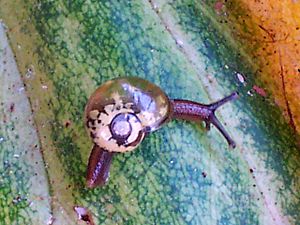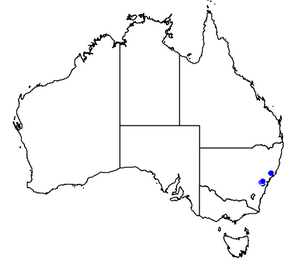Helicarion porrectus facts for kids
Quick facts for kids Helicarion porrectus |
|
|---|---|
 |
|
| Mysticarion porrectus from the Tia River, Great Dividing Range, Australia | |
| Conservation status | |
| Scientific classification | |
| Kingdom: | |
| Phylum: | |
| Class: | |
| (unranked): |
clade Heterobranchia clade Euthyneura
clade Panpulmonata clade Eupulmonata clade Stylommatophora clade Sigmurethra clade limacoid clade |
| Superfamily: |
Helicarionoidea
|
| Family: |
Helicarionidae
|
| Genus: |
Mysticarion
|
| Species: |
M. porrectus
|
| Binomial name | |
| Mysticarion porrectus Iredale, 1941
|
|
| Synonyms | |
|
Helicarion porrectus |
|
The Mysticarion porrectus is a special kind of snail that lives in trees. It's also known as Helicarion porrectus. This snail belongs to a family called Helicarionidae. You can only find this snail in Australia, which means it is endemic there.
These snails like to live in and around rainforests that are high up in the mountains of eastern Australia. They are often found in cool, temperate rainforests that have trees like Antarctic beech, Sassafras, and Pinkwood.
You can find Mysticarion porrectus from Mount Gulaga in southeastern New South Wales all the way up the Great Dividing Range to Mount Superbus. This mountain is about 150 kilometers southwest of Brisbane, Queensland.
Contents
What Does This Snail Look Like?
This snail has a very thin and clear shell. This means you can actually see its brightly colored organs inside! It also has a special gland at the end of its tail. Scientists think this gland might release chemicals called pheromones to attract a mate during courtship.
Why is it Called a Semi-Slug?
The shell of the Mysticarion porrectus is too small for the snail to pull its whole body inside. This type of snail is called a "semi-slug". Over a long time, its shell has become smaller and thinner. Now, the shell mostly protects its important internal organs.
This shell reduction has happened in many different snail families. In some families, like the Athoracophoridae, Cystopeltidae, and Limacidae, the shell has completely disappeared or become a tiny internal plate. These animals are called slugs. Slugs are basically snails that have lost their outer shell.
Scientists believe that some snails lost their shells because there wasn't enough calcium carbonate in the rocks or soil. Snails need calcium carbonate to build their shells.
In the Helicarionidae family, you can find many different types of shells. Some species have large, full shells they can hide in. Others have very small, ear-shaped, or plate-like shells that sit on their backs like a saddle.
How This Snail Lives
This snail is a herbivore, which means it eats plants. It scrapes off thin layers of things like algae and sooty mold from the surface of living leaves.
The Mysticarion porrectus often rests on the leaves of small plants and young trees. It also rests on the trunks of bigger trees. It usually lies on its side, with the end of its tail curled back. This part of its tail can act like a suction cup.
Because the snail rests on leaves, it can sometimes be picked up by accident. Other animals, cars, or even people might brush against the leaves and carry the snail to a new place without knowing it. Most snails that live in trees have very sticky mucus. This "hitchhiking" ability might explain why some smaller snail species are found in so many different places. They could easily travel on the feet or legs of birds or bats!
Where in the World Do They Live?
The Helicarionidae family is thought to have originated from Gondwana. This is because most of them live in parts of the Southern Hemisphere and Southeast Asia, including Oceania and South Africa.
In Australia, most helicarionid snails are found along the eastern coast and mountain ranges. They are especially common in the Border Ranges and Wet Tropics areas. A few species live in South Australia. One species is found in the rainy area of southwestern Western Australia, and two species live in the Kimberley region.
Gallery
See also
 In Spanish: Helicarion porrectus para niños
In Spanish: Helicarion porrectus para niños






